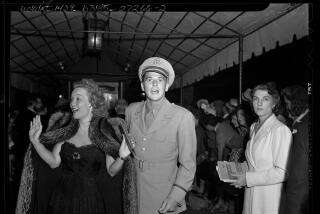Living Legal
- Share via
The new “Living Together Kit” out from Nolo Press in February is more than an updated legal guide for unmarried couples. The book’s eighth edition represents a sea change in the way Americans view marriage, said co-author Ralph Warner.
“Twenty year ago, living together was illegal in most states and considered immoral and depraved by many people,” he said. “Today it has become routine.”
How routine? Census demographics indicate that the number of unmarried couples under the same roof in the United States has grown over the last 25 years from 523,000 to 3.7 million; almost a third of these couples are raising children.
In Nolo’s first edition in 1978, unwed couples dealt with such hurdles as the near impossibility of getting a loan based on both of their incomes or of buying insurance together. “We even discussed the ethics of wearing wedding rings when you went for a loan,” said Warner, 55, a former legal aid lawyer.
In contrast, today’s edition deals with the lack of legal structure for unmarried partners and how to fill the gap with documents aimed at avoiding problems.
“It’s a total turnaround,” Warner said. As co-founder and publisher of Berkeley’s Nolo Press, a pioneer in the “do your own law” movement, he has monitored the changing social status of living together for more than 25 years. And he has personal experience. He co-wrote the book with his partner, anthropologist-turned-lawyer Toni Ihara. After living together for 19 years, the two are now married.
“We’ve gone from a time in which everything was illegal to a time when basically everything is legal,” he said. That’s because most states have decriminalized private consensual acts between adults.
But while moving in together is easier than in the past, he said, the time usually comes when unmarried partners want to buy a house and they’re forced to start asking, “How do we do this?” They’ll find the answer in the “Living Together Kit.” A typical Nolo publication, it’s a nuts-and-bolts guide of breezy narration, crisp information and a section of tear-out living together contracts covering everything from “Acknowledgment of Parenthood” to “Making a Will.”
Warner emphasizes that living together is not legally complicated. “It’s mostly common sense,” he said. “If you totally lawyer this whole thing up and say people need 77 contracts, they’ll look at it as a lot of unromantic malarkey and won’t do it.”
Although the book offers legal guidance for dozens of situations, Warner said that for most couples there are four basic areas that are potential pitfalls.
Unmarried partners must choose how to record the deed or take title. They may choose joint tenancy, which means they share the house equally; if one dies, the other is the automatic heir. Or they might prefer tenancy in common, which is 50-50 ownership with each partner specifying his or her own heir. “This is often preferred by older couples who have separate families,” Warner said. “Each member of the couple can choose their own heirs.”
HAVING A CHILD
“Mainly you should document that you are the parents,” Warner said. “This protects the child if one of you should die.” His book offers two forms--the acknowledgment of paternity, which is traditional, or the acknowledgment of parenthood by both partners. He prefers the latter, in which both parents pledge their duty to raise and support the child. “It’s just nicer,” he said.
MAKING A WILL
A will is relatively simple to make and easy to change or revoke, Warner said. It lets you leave your property to anyone you wish, including the person you live with. Otherwise it will go to your nearest blood relative, “which could well be your Aunt Tillie in Omaha who disapproved of your relationship in the first place.”
DISPARATE INCOMES
Not a problem for everyone, Warner said. “For young people just starting to earn, or any couple making roughly the same amount, sitting down and making a contract doesn’t serve much purpose.”
But there are many other categories: professional couples with one staying home to take care of the children; couples with one putting another through school; high earner / low earner couples. “It becomes really important to decide if the income belongs to both of us or not,” Warner said.
Nolo updates its books regularly, Warner said, but this area has changed more than most from the days when “living together” was considered Bohemian and slightly scandalous. “I think what happened is that we changed our attitudes about everything in the 1960s, and it took the law 10 to 15 years to catch up,” he said.
He acknowledged that some people are still made uncomfortable by people living together but thinks acceptance will continue to grow. “I saw a recent poll saying that two-thirds of the people thought that gay couples should have legal rights as domestic partners.” (Although most of the information in “Living Together” is applicable to gay couples, a better reference is Nolo Press’ “A Legal Guide for Lesbian and Gay Couples,” which was updated in 1996.)
Many factors are playing into the changing picture of marriage. At one end of the spectrum, young people are waiting longer to get married and, at the other end, as people are living longer, millions are outliving their spouses. If fact, the book notes, if the trend toward living together among adults at both ends of the age spectrum continues, marriage might become primarily a phenomenon of people’s middle years.
More to Read
Sign up for our Book Club newsletter
Get the latest news, events and more from the Los Angeles Times Book Club, and help us get L.A. reading and talking.
You may occasionally receive promotional content from the Los Angeles Times.










